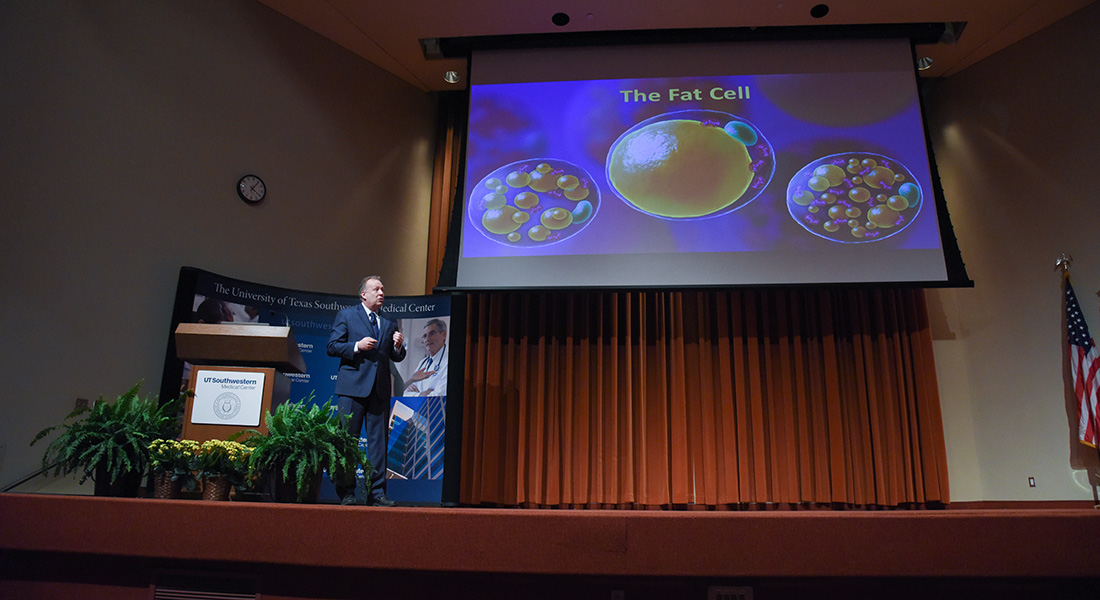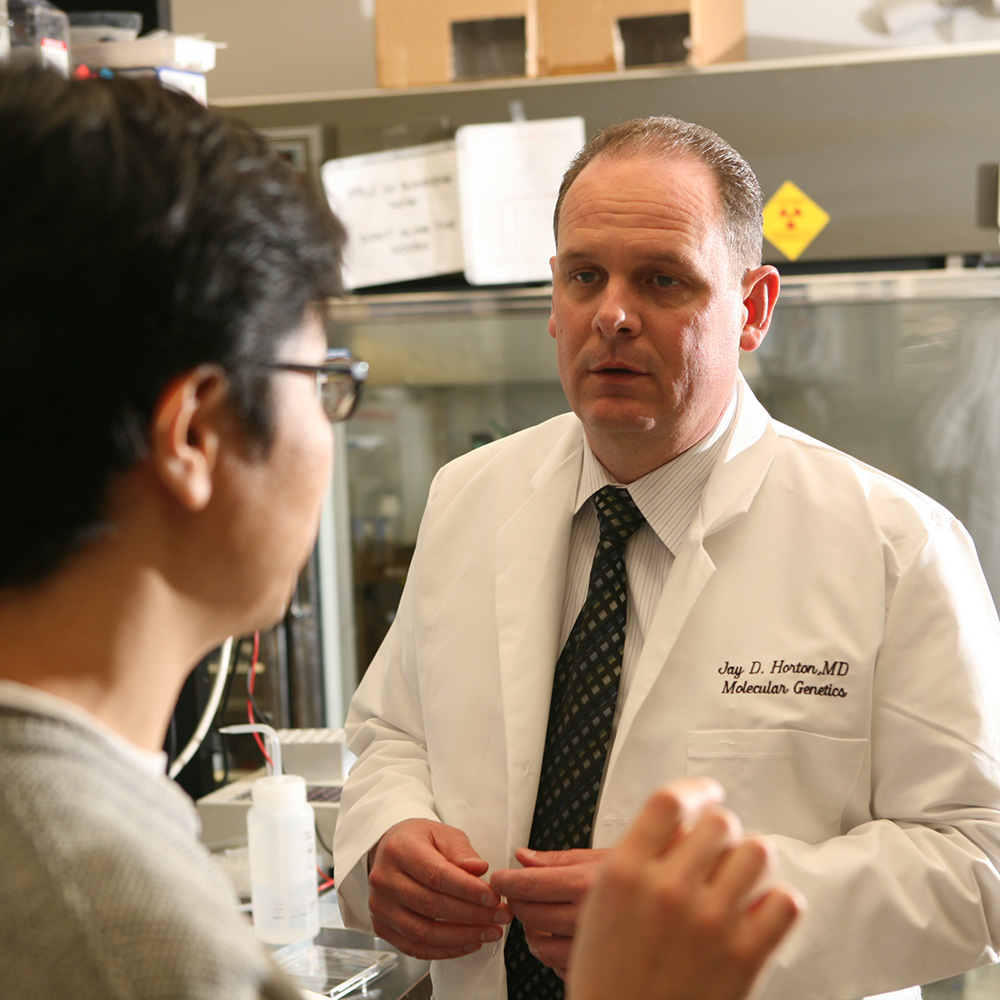UT Southwestern designated one of 12 elite Nutrition Obesity Research Centers in the nation
NORC, the only one in Texas, to investigate causes, prevention, and treatment options for $175 billion obesity epidemic

DALLAS – Sept. 21, 2022 – UT Southwestern Medical Center has been selected to be one of 12 NIH Nutrition Obesity Research Centers in the nation – and the only one in Texas – to investigate the causes, prevention, and treatment options for obesity, a chronic disease affecting more than 40% of the U.S. population with medical costs nearing $175 billion.
More than 150 UT Southwestern scientists across dozens of departments in fields ranging from metabolism to genetics will be part of the elite National Institutes of Health-funded, university-wide interdisciplinary research center. UT Southwestern will receive $6.15 million in grant funding over five years from the National Institute of Diabetes and Digestive and Kidney Diseases. Among the center’s faculty are three Nobel Laureates, 11 members of the National Academy of Sciences, seven members of the National Academy of Medicine, and seven Howard Hughes Medical Institute Investigators.

“The UT Southwestern Nutrition Obesity Research Center provides an important mechanism to accelerate translation of basic scientific discoveries into clinically relevant interventions to improve public health,” said Jay Horton, M.D., Director of the Center for Human Nutrition at UT Southwestern and Director of the new Nutrition Obesity Research Center.
Over the last 20 years, the prevalence of U.S. obesity has risen steadily from 30% to 42%, with the prevalence of severe obesity nearly doubling to 9.2%, according to the National Health and Nutrition Examination Survey from the Centers for Disease Control and Prevention. Obesity takes a greater toll on people of color – reported in nearly 50% of non-Hispanic Black adults, more than 45% of Hispanic adults, 41% of non-Hispanic white adults, and 16% of non-Hispanic Asian adults. Medical costs for obese adults are more than $1,800 higher than for those with healthy weight.
Obesity-related conditions include heart disease, stroke, Type 2 diabetes, nonalcoholic fatty liver disease, and several types of cancer, all among the leading causes of preventable, premature death, according to the CDC.

“Ultimately, our goal is to enhance the innovative nutrition and obesity research these investigators are currently engaged in and facilitate the translation of basic scientific discoveries into new therapeutic strategies for the prevention and treatment of obesity and the metabolic syndrome,” said Philipp Scherer, Ph.D., Professor of Internal Medicine and Cell Biology at UT Southwestern, Director of the Touchstone Diabetes Center, and Associate Director of the Nutrition Obesity Research Center.
The Obesity Center’s research base consists of 158 investigators from 27 different departments, along with members of UT Southwestern’s Peter O’Donnell Jr. Brain Institute, Harold C. Simmons Comprehensive Cancer Center, Center for Human Nutrition, Peter O’Donnell Jr. School of Public Health, and UT Southwestern School of Health Professions. Collectively, these researchers have 230 nutrition and obesity-related research grants and research support totaling more than $74 million a year, including funding from the NIH, Department of Defense, Howard Hughes Medical Institute, American Diabetes Association, National Cancer Institute, and the Cancer Prevention and Research Institute of Texas.
UT Southwestern has continued to strengthen its expertise in the field with assistance from the state of Texas, which provided $8 million per year for obesity-related research to UT Southwestern in 2009-11 and $6.5 million in subsequent years (2011-19) that not only helped demonstrate the commitment of UT Southwestern and the state of Texas to addressing the epidemic, but also facilitated the development of the current diverse and accomplished group of investigators that comprise the new center.
“We have assembled a highly interactive and collaborative interdisciplinary team of investigators with a goal of defining the behavioral, metabolic, genetic, and molecular mechanisms contributing to obesity and obesity-induced disease,” said Dr. Horton, Professor of Internal Medicine in the Division of Digestive and Liver Diseases, with a secondary appointment in Molecular Genetics.
To facilitate interdisciplinary research and the exchange of ideas, the UTSW Nutrition Obesity Research Center has created four thematically related teams:
- Team 1: Central Regulation of Energy Metabolism
- Team 2: Adipocyte Biology and Energy Metabolism
- Team 3: Obesity-Induced Peripheral Organ Disease
- Team 4: Nutrition, Obesity, and Cancer
“Within each team, we have integrated basic and translational scientists from a wide spectrum of disciplines to comprehensively address the biochemical, metabolic, and clinical consequences of obesity and obesity-related diseases,” said Dr. Horton.

A Pilot and Feasibility program, directed by Joel Elmquist, D.V.M., Ph.D., and Associate Director of the Nutrition Obesity Research Center, and Joyce Repa, Ph.D., Associate Professor of Physiology and Internal Medicine, will support early-stage projects of four new investigators per year. An Enrichment Program, led by Jeffrey Zigman, M.D., Ph.D., Professor of Internal Medicine and a Principal Investigator in the Center for Hypothalamic Research, will provide enhanced educational opportunities for graduate students, postdoctoral fellows, and faculty interested in performing basic science and translational research related to nutrition, obesity, and obesity-related diseases.
Four cores and a clinical element also have been established to provide state-of-the art services: Animal Phenotyping/Metabolism Core; Lipid Mass Spectrometry Core; Quantitative Metabolism and Imaging Core; and Genetics, Single Cell Sequencing, and RNA Sequencing Core.
Dr. Elmquist holds the Maclin Family Distinguished Professorship in Medical Science, in Honor of Dr. Roy A. Brinkley, and the Carl H. Westcott Distinguished Chair in Medical Research.
Dr. Horton holds the Center for Human Nutrition Director’s Endowed Chair, the Scott Grundy Director's Chair, The Dr. Robert C. and Veronica Atkins Chair in Obesity & Diabetes Research, and the Distinguished University Chair in Human Nutrition.
Dr. Scherer holds the Gifford O. Touchstone, Jr. and Randolph G. Touchstone Distinguished Chair in Diabetes Research and the Touchstone/West Distinguished Chair in Diabetes Research.
Dr. Zigman holds the Kent and Jodi Foster Distinguished Chair in Endocrinology, in Honor of Daniel Foster, M.D., The Diana and Richard C. Strauss Professorship in Biomedical Research, and the Mr. and Mrs. Bruce G. Brookshire Professorship in Medicine.
Table 1. Major Discoveries by UT Southwestern Scientists that Opened New Areas of Research in Nutrition, Obesity, and Associated Comorbidities.
| Discovery | Scientist | Year |
|---|---|---|
| Role of glucagon in glucose homeostasis and excess in diabetes | Unger | 1969, 1978 |
| LDL receptor and genetic basis of familial hypercholesterolemia | Brown & Goldstein | 1974 |
| Regulatory role of malonyl-CoA in fatty acid oxidation | McGarry & Foster | 1977 |
| Receptor-mediated endocytosis | Goldstein, Anderson, & Brown | 1979 |
| Endothelins and endothelin receptors | Yanagisawa | 1988 |
| Role of C/EBP in adipogenesis | McKnight | 1991 |
| Abnormal fatty acid metabolism in etiology of Type 2 diabetes | McGarry | 1992 |
| Sterol regulatory element binding proteins (SREBPs) | Brown & Goldstein | 1993 |
| SF1 and endocrine gland development | Parker | 1994 |
| TZDs as PPARg ligands | Kliewer | 1995 |
| Discovery of adiponectin | Scherer | 1995 |
| Oxysterols are LXR ligands | Mangelsdorf | 1996 |
| Alternate pathway of bile acid synthesis | Russell | 1998 |
| Orexins and orexin receptors | Yanagisawa | 1998 |
| Cloning of beclin 1 and critical role in autophagy | Levine | 1999 |
| Leptin therapy for lipodystrophy | Brown & Goldstein (mice); Garg (humans) |
1999, 2002 |
| Mouse models of fatty liver and metabolic syndrome | Horton, Brown, Goldstein & Mangelsdorf | 1996, 2005 |
| SREBP’s role in NAFLD | Horton | 1999 |
| SIM1 and genetic basis of profound obesity | Zinn | 2000 |
| ABCG5/ABCG8 and genetic basis of sitosterolemia | Hobbs | 2000 |
| Discovery of ChREBP | Uyeda | 2001 |
| First large population-based study of prevalence of NAFLD | Browning, Horton, Grundy, Vega, Cohen, & Hobbs | 2005 |
| PCSK9 destroys LDLRs and inactivation mutations lower LDL and prevents heart attacks | Horton, Cohen, & Hobbs | 2006 |
| ANGPLT4 variants cause low plasma TGs and high LDL | Cohen & Hobbs | 2007 |
| Expansion of white fat prevents insulin resistance in extreme obesity | Scherer | 2007 |
| Characterization of the neurons that mediate the actions of Belviq | Elmquist | 2008 |
| Identification of PNPLA3’s role in NAFLD | Cohen & Hobbs | 2008 |
| Discovery of GOAT, the enzyme that activates Ghrelin | Brown & Goldstein | 2008 |
| Identification of leptin target neurons that regulate liver physiology | Elmquist | 2010 |
| Discovery of Zfp423 and role in preadipocyte determination | Gupta | 2010 |
| Actions of adiponectin are mediated by activation of ceramidase activity | Scherer | 2011 |
| Role of lipogenesis in pathogenesis of NAFLD | Horton, Brown, & Goldstein | 2012, 2017 |
| Discovery of TM6SF2 and role in NAFLD and hypolipidemia | Cohen & Hobbs | 2014 |
| FGF21, a hepatic hormone that acts centrally to induce weight loss | Mangelsdorf & Kliewer | 2014 |
| An adipo-biliary-uridine axis that regulates energy homeostasis | Scherer, Hill, Horton, & Elmquist | 2017 |
| Elucidation of central pathway by which Olanzipine induces weight gain | Liu & Elmquist | 2017 |
| Reduction in leptin improves leptin sensitivity, uncovering a new avenue to treat of obesity | Scherer & Elmquist | 2019 |
| Discovery that LEAP2, a GHSR antagonist, blunts ghrelin action in obese states | Zigman | 2019 |
About UT Southwestern Medical Center
UT Southwestern, one of the nation’s premier academic medical centers, integrates pioneering biomedical research with exceptional clinical care and education. The institution’s faculty has received six Nobel Prizes, and includes 26 members of the National Academy of Sciences, 17 members of the National Academy of Medicine, and 14 Howard Hughes Medical Institute Investigators. The full-time faculty of more than 2,900 is responsible for groundbreaking medical advances and is committed to translating science-driven research quickly to new clinical treatments. UT Southwestern physicians provide care in more than 80 specialties to more than 100,000 hospitalized patients, more than 360,000 emergency room cases, and oversee nearly 4 million outpatient visits a year.
